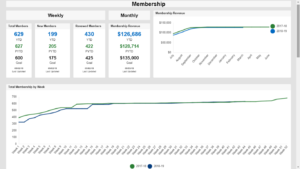The effectiveness of a leadership group is never tested more than when it is met with conflict. While there are many factors that contribute to a board’s ability to lead well, there is one deceivingly simple question to pose, the answer to which is predictive of the board’s chances to thrive and lead uninterrupted, even during a crisis: Does the board have a shared vision for the future?
If it does have a futuristic shared vision, it is almost certainly because the organization has a data-driven, well-supported, living and breathing strategic plan in place. In my 15 years working in the association management industry, the congruence of shared vision and board bought-in strategy are invaluable keys to success.
How does a board get to this optimal state? The answer is complex, as many attributes of boards tend to be, but certainly achievable. The responsibilities of board members during their tenures as elected leaders are intricate, characterized by servant leadership, requiring the balance of ethics, repression of personal interests and ensuring the vitality and future of the organization served. Aligning a group of intentionally heterogenous individuals, as broad representation is inherent to a board’s nature, is no easy feat. Do not be discouraged! Read on for some tips and tricks to help you get there.
Step One: Agree on the Crucialness of Strategy
If your organization does not have a strategic plan, start advocating for one. The very nature of leadership is to lead, implying futuristic thinking. Focusing the board’s collective energies only on the here and now ultimately leads to stagnancy, disinterested board members and even worse, disengaged members. A lack of strategy exposes the organization to unnecessary risks: wasted time and resources at best, and at worst, this could lead to the failure of the board to complete its basic core function: to serve its members.
Step Two: Listen, Engage & Empower
Your board, committee and volunteer members are more likely to support the strategy if they feel they had a part in creating it. If a small group of individuals sit in on a few Zoom calls and crank out a one-pager with “Strategic Plan” slapped at the top, the chances for its success are dismal at best. Effective plans are inclusive, developed collaboratively among various organizational levels beyond the board itself: committees, staff members, members themselves and other constituents – the list of valuable input sources is limited only by your time and resources.
Step Three: Implement & Analyze
A plan optimized for success has a few components:
- An executive summary that elucidates the plan’s high-level goals and conveys its longevity. Plans are intended to be 3-5 years in length and revisited at least annually (more on that later). Showcase this to your members so that they know you are listening to them and they know what their dues dollars are supporting.
- An implementation plan with tactics clearly assigned. This is a great way to engage your committees in the plan – invite them to take the lead on achieving the goals relevant to their respective committee charge. Be sure to identify measurable metrics so that progress can be clearly tracked.
- A well-maintained strategic plan dashboard that clearly and transparently shows what the organization is doing to achieve its shared vision. This component is so important that it warrants its own subheading.
Step Four: Consistently Assess Progress
Consistent and transparent communication of the plan’s progress is perhaps the most crucial component to its successful implementation. The most well-thought out strategy in the world is useless if it sits in all its frightful complexity unopened on a shelf or on a computer drive.
We are successful in helping our boards achieve their shared vision by providing a framework that simplifies progress via online dashboards. Constantly updated by staff in consultation with leaders, the dashboards are accessible to board members at any time.

Though packed with data, the dashboards convey progress in a comprehensive visual format. It’s easy to see where boards need to focus more time and resources to ensure that goals are achieved. The dashboards are populated by living data: data about membership renewals, sponsorship income, conference registrations, and more. An informed board is an empowered board, and this is what we strive to achieve for all our leaders.
Step Five: Pivot to Ensure Relevance
An effective strategic plan is fluid in that it can be, and must be, tweaked and revised on a regular basis to remain relevant and timely amid constantly shifting circumstances. At a minimum, the plan should be revisited annually, and a quarterly cadence is even better. Doing this ensures that your organization is well-prepared to maintain operations as usual, even in times of crisis.
It’s safe to say that 2020 threw us curveballs that we did not expect – at home, at work, in our organizations – in every facet of our every day lives. Organizations with sound strategies and strong boards are well equipped to refocus on the bigger picture – their shared vision – to help them navigate any crises that come their way.